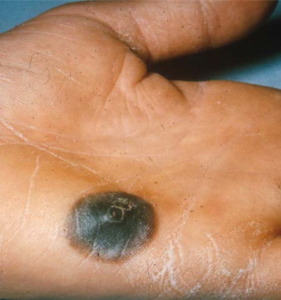We have talked about anthrax several times in this blog and have focused on the “biological weapon” aspect of anthrax. We can refresh our memory by following these links : North Corea and anthrax, Sverdlovsk, Sverdlovsk again, 2001 October letter-bomb, Gruinard Island
The outbreak this summer of a serious epidemic in France allows us to recall what anthrax is and how it can be the origin of a biological weapon.
The Facts
There are 28 farms in the Hautes-Alpes that have been affected by anthrax. About 50 animals (cows, sheep, horses) died as a result of the infection. The first cases were observed in Montgardin (near Gap) where 6 cows were found dead. The disease spread to 13 communes in 2 months
This disease is also called “anthrax” in Anglo-Saxons and should not be confused with a pathology called anthrax in French, generally due to Staphylococcus and which is an accumulation of several furuncles with necrotizing tendency.
The bacterium responsible for anthrax is called Bacillus anthracis, it is a Gram-positive bacillus whose spore is extraordinarily resistant (spores found in Egyptian mummies have been able to germinate to restore vegetative forms!) Dead animal corpses buried in the soil contain a significant number of B. anthracis spores that can be brought to the surface of the soil, particularly by earthworms. Healthy animals can then pasture contaminated grass and become sick in turn. In Pasteur’s time, the contaminated fields were called “cursed fields”. In recent cases, it is the dryness that causes the earth to graze mixed with the summer pasture, which then contains spores that storm water runoff has uncovered.
Animals (herbivores) ingest the germ and develop a gastrointestinal anthrax which is characterized by a high fever, their blood becomes incoagulable and all black (like anthrax, hence the name of the disease) and the animals eventually die of a generalized infection (sepsis). The whole animal is then contaminated and can transmit the disease to humans. Sporadic cases exist worldwide and occasional outbreaks occur in Central Asia and Africa.
As soon as a case of anthrax is diagnosed, the other animals are vaccinated (animal vaccine) so that the disease does not spread and this is how 500 cattle and goats from the Bourrines farm in Bertholène in Aveyron were vaccinated in July. Then the vaccination of the animals was extended to the territory of 17 other communes. It was Pasteur who first tested a vaccine against anthrax by injecting an attenuated bacillus that protected them from the disease. This experiment remained famous was carried out on a farm in Pouilly le fort (France). The veterinary vaccines came to lack this year and talks are currently conducted at the European level for a use of the stocks of the various countries.
Human disease
Currently, cases of transmission to humans are extremely rare and no one was ill during this summer’s episode.
The different types of anthrax
Skin infections account for 95 to 99% of cases. Other infections may be gastrointestinal or pulmonary.
The skin form follows the contamination of the skin by a sick animal, the bacillus penetrating the skin because of a cut or excoriation. A black ulcer then forms, followed by necrosis. This form of the disease is not fatal unless effective treatment is not put in place quickly. One can see these manifestations in the case of animal carcass transporters for example (occupational disease).

Black anthrax pustule on the hand
The gastrointestinal form follows the ingestion of contaminated meat. This is followed by acute inflammation of the intestine. Patient experiences nausea, vomiting, abdominal pain and diarrhea. Depending on the conditions, mortality can be as high as 60%. It is reported that in 2009, about fifteen people died in Uzbekistan from eating meat from a contaminated cow carcass while children were also contaminated while swimming in the river where the animal’s viscera had been thrown.
The most dangerous form is the pulmonary form, which is the inhalation of spores into the air. Within a few days severe breathing disorders appear leading irreparably to septic shock leading to death if no therapeutic management is put in place. The most frequent situations are those involving the tanning of the skin or the treatment of wool. In the last century, this disease was also called “wool sorter’s disease”. It is also this form of the disease that is feared in the context of the biological weapon consisting of B. anthracis spores.
 Wool sorters
Wool sorters
Pathogenicity
It is due to a polypeptide capsule (whose gene is located on the plasmid pXO2) and a toxin consisting of 3 proteins (whose genes are located on the plasmid pX01): PA protective antigen, LF lethal factor, EF oedema factor. The “Stern” strain which has lost its plasmid pX02 no longer synthesizes a capsule and is therefore easily phagocytated by the host polynuclears (the capsule strain resists phagocytosis). This strain is used as a live attenuated strain for animal vaccines.
Prevention and diagnosis
The diagnosis of pulmonary infection is made on an X-ray completed by a scanner. For all forms, the level of antibodies or toxins in the blood can be measured and B. anthracis can be checked in the various samples. Antibiotic treatment is based on penicillin use: amoxicillin[clamoxyl®], fluoroquinolones: ciprofloxacin[ciflox®], cyclines: doxycycline[tolexine®]. When there is doubt of contact with a sick animal or inhalation of spores, the patient is treated as a preventive measure with ciprofloxacin. This was the case this summer for half of the 103 people in the Hautes-Alpes reported having potentially been in contact with infected animals (farmers, veterinarians, slaughterhouse workers). The treatment takes 60 days, it is sometimes the time necessary for the spores to germinate giving vegetative forms secreting toxins. Only vegetative forms are susceptible to antibiotics.
The spore: biological weapon
Much research has been done around the world to modify B. anthracis spores to militarize them. It is indeed difficult to spread spores in the atmosphere so that they penetrate directly into the lungs and give the most frightening lung disease. The spores are relatively heavy and settle quickly to settle on surfaces where they are then ineffective. It is therefore necessary to prevent the fixation of spores on surfaces when they are aerosolized by reducing electrostatic forces, for example. These spores are considered to be at the top of the list of agents that can be used in the case of a biological weapon or bioterrorism. Reference can be made to the articles concerning the events of October 2001 or the one relating the industrial production of spores in Sverdlosk by the USSR. The strain used in the USA in 2001 was an “Ames” strain transformed into militarized powder.
Vaccines
There are vaccines against anthrax mainly for veterinary use. Human vaccines have uneven tolerance, and their effectiveness is often poor (about 40%). They must be reserved for the following groups:
– laboratory personnel working on the bacteria
– people handling animal products that may be infected in areas at risk
– veterinarians practicing in regions where the disease is endemic
– military in areas where there is a significant risk of the use of biological weapons.
There is currently no indication of vaccination in France.
Conclusion
Anthrax is a disease of herbivores. It is due to the presence of Bacillus anthracis spores in the grass consumed by animals. Animals die after developing a gastrointestinal charcoal during which the animal is completely invaded by the vegetative form (the form of bacteria that multiplies), all organs are affected including its skin. When the animal dies, if it is buried in the soil, the bacteria form a resistance The spores are brought to the surface by earthworms or during a drought-storm episode. If an animal consumes these spores, they will “germinate” in the latter by giving again a vegetative form which will multiply and invade the animal.
Transmission in humans is very rare: it can occur through the skin (contact with the animal’s skin for example), digestive (consumption of contaminated meat) or even pulmonary (inhalation of spores contained in the air). The spores will germinate (sometimes up to 60 days) and give the disease. The preventive and curative means of anthrax are very effective.
The so-called “massive disorganization” biological weapon consists of a suspension of spore in the air, which is spread over populations and gives very serious pulmonary forms. This weapon is very difficult to develop and the tests carried out by various terrorist groups have not been conclusive. It should nevertheless be noted that the letter bombings in 2001 in the USA killed 5 people. The spores distributed in the form of “white powder” contained in envelopes were released into the atmosphere as they passed under the post office’s automatic sorters.
Autor: Prof. François Renaud



